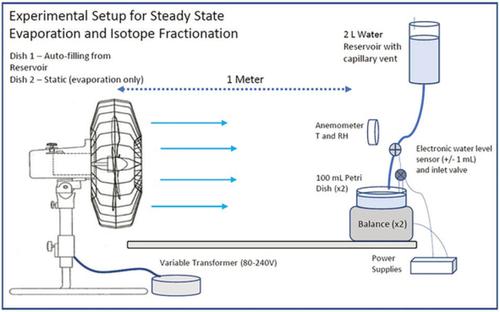当前位置:
X-MOL 学术
›
Hydrol. Process.
›
论文详情
Our official English website, www.x-mol.net, welcomes your
feedback! (Note: you will need to create a separate account there.)
Stable isotope fractionations in the evaporation of water: The wind effect
Hydrological Processes ( IF 2.8 ) Pub Date : 2020-06-17 , DOI: 10.1002/hyp.13804 Roberto Gonfiantini 1 , Leonard I. Wassenaar 1 , Luis J. Araguas‐Araguas 1
Hydrological Processes ( IF 2.8 ) Pub Date : 2020-06-17 , DOI: 10.1002/hyp.13804 Roberto Gonfiantini 1 , Leonard I. Wassenaar 1 , Luis J. Araguas‐Araguas 1
Affiliation

|
We performed pan evaporation experiments with the objective of exploring the behaviour of the long‐standing Craig–Gordon (C–G) stable isotope model for evaporation under different conditions of air turbulence. The water lost through evaporation was automatically replenished so that a steady isotopic composition was reached, the value of which depended on the isotopic composition of the replenishment water and environmental parameters like temperature, relative humidity and isotopic composition of the atmospheric vapour, and the air turbulence index. The pans were exposed to artificial winds ranging from 0 to 2.5 m/s to change the air turbulence index, which governs the repartition between vapour transported by molecular diffusion and turbulent diffusion. Our data revealed that for wind speeds >0.5 m/s the isotopic composition of the evaporating water deviated from that predicted by the C–G model. This deviation was hypothetically attributed to microdroplets of liquid water removed by the wind without any isotopic fractionation. Isotope mass balance equations allowed us to quantify this water loss, which at wind speeds of ~2 m/s reached 10% of the total evaporation losses. An alternative kinetic evaporation model was proposed whereby the equilibrium layer and the atmospheric laminar layer above the evaporating water of the C–G model were destroyed by the wind and evaporated water molecules were directly injected into the atmosphere. In this model, the isotopic fractionations were due to the slower kinetics of hydrogen bond breakage between molecules in liquid water when heavy isotopes are involved. Accordingly, our data suggested that for isotope water balance studies where winds are frequently above 2 m/s, the C–G model may be inadequate without appropriate corrections for spray vaporization, or the introduction of appropriate kinetic isotope fractionation factors.
中文翻译:

水蒸发中稳定的同位素分离:风效应
我们进行了锅蒸发实验,目的是探索长期存在的克雷格-戈登(C-G)稳定同位素模型在不同湍流条件下蒸发的行为。通过蒸发损失的水分会自动补充,从而达到稳定的同位素组成,其值取决于补充水的同位素组成以及环境参数,例如温度,相对湿度和大气蒸气的同位素组成以及空气湍流指数。锅暴露在0到2.5 m / s的人造风中以改变空气湍流指数,该指数决定了分子扩散输送的蒸汽与湍流扩散之间的分配。我们的数据显示风速> 0时。5 m / s的蒸发水同位素组成与CG模型所预测的偏离。假设该偏差归因于没有任何同位素分馏的风去除的液态水的微滴。同位素质量平衡方程式使我们能够量化这种水损失,在〜2 m / s的风速下,水损失达到总蒸发损失的10%。提出了一种替代的动力学蒸发模型,该模型通过风破坏C–G模型蒸发水上方的平衡层和大气层流层,并将蒸发的水分子直接注入大气中。在此模型中,同位素分馏是由于当涉及重同位素时液态水中分子之间氢键断裂的动力学较慢。因此,
更新日期:2020-06-17
中文翻译:

水蒸发中稳定的同位素分离:风效应
我们进行了锅蒸发实验,目的是探索长期存在的克雷格-戈登(C-G)稳定同位素模型在不同湍流条件下蒸发的行为。通过蒸发损失的水分会自动补充,从而达到稳定的同位素组成,其值取决于补充水的同位素组成以及环境参数,例如温度,相对湿度和大气蒸气的同位素组成以及空气湍流指数。锅暴露在0到2.5 m / s的人造风中以改变空气湍流指数,该指数决定了分子扩散输送的蒸汽与湍流扩散之间的分配。我们的数据显示风速> 0时。5 m / s的蒸发水同位素组成与CG模型所预测的偏离。假设该偏差归因于没有任何同位素分馏的风去除的液态水的微滴。同位素质量平衡方程式使我们能够量化这种水损失,在〜2 m / s的风速下,水损失达到总蒸发损失的10%。提出了一种替代的动力学蒸发模型,该模型通过风破坏C–G模型蒸发水上方的平衡层和大气层流层,并将蒸发的水分子直接注入大气中。在此模型中,同位素分馏是由于当涉及重同位素时液态水中分子之间氢键断裂的动力学较慢。因此,











































 京公网安备 11010802027423号
京公网安备 11010802027423号